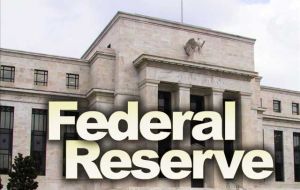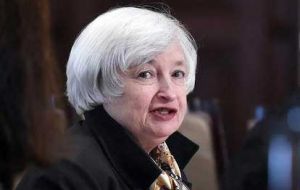MercoPress. South Atlantic News Agency
Fed minutes confirm reveal consensus on ending stimulus program
 Most observers expect the Fed will begin raising the rate in the middle of 2015, mostly in an effort to keep inflation in check as the US recovery gathers steam.
Most observers expect the Fed will begin raising the rate in the middle of 2015, mostly in an effort to keep inflation in check as the US recovery gathers steam.  However, US Fed chair Janet Yellen has sought to reassure market participants that the bank will not act in haste
However, US Fed chair Janet Yellen has sought to reassure market participants that the bank will not act in haste Although the US Federal Reserve was worried about turmoil in emerging markets, the central bank reached an easy consensus to end its stimulus program, its latest minutes reveal.
Minutes from the central bank's October meeting show officials were concerned about stock market fluctuations and weakness abroad. However, they worried that saying so could send the wrong message.
Overall, officials were confident the US economy was on a strong footing. That is why they decided to end their stimulus program- known as quantitative easing (QE) - in which the Fed bought bonds in order to keep long-term interest rates low and thus boost spending.
“In their discussion of the asset purchase program, members generally agreed . . . there was sufficient underlying strength in the broader economy to support ongoing progress toward maximum employment,” read the minutes, referring to the decision to end QE.
US markets reacted in a muted way to the news, with the Dow Jones briefly rising before falling once more into the red for the day.
However, to reassure markets that the Fed would not deviate from its set course, the central bank decided to keep its “considerable time” language in reference to when the Fed would raise its short term interest rate.
That interest rate - known as the federal funds rate - has been at 0% since late 2008, when the Fed slashed rates in the wake of the financial crisis.
Most observers expect that the bank will begin raising that rate in the middle of 2015, mostly in an effort to keep inflation in check as the US recovery gathers steam.
However, US Fed chair Janet Yellen has sought to reassure market participants that the bank will not act in haste and remains willing to change its timeline should economic conditions deteriorate in the US.
The minutes also show that the Fed is still concerned about possibly lower-than-expected inflation, particularly as oil prices continue to decline and wage growth remains sluggish.
“Many participants observed the Committee should remain attentive to evidence of a possible down shift in longer-term inflation expectations; some of them noted if such an outcome occurred, it would be even more worrisome if growth faltered,” they read.
That led some on Wall Street to believe that the central bank might put off a rate rise even further into the future, if the outlook for inflation changes significantly.




Top Comments
Disclaimer & comment rulesCommenting for this story is now closed.
If you have a Facebook account, become a fan and comment on our Facebook Page!